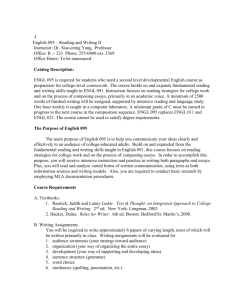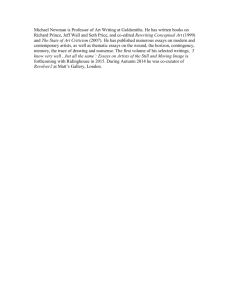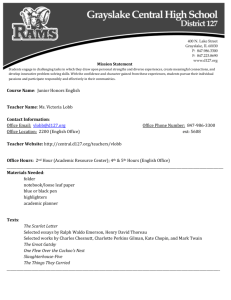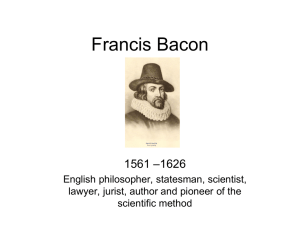ENGLISH 102—English Composition II
advertisement
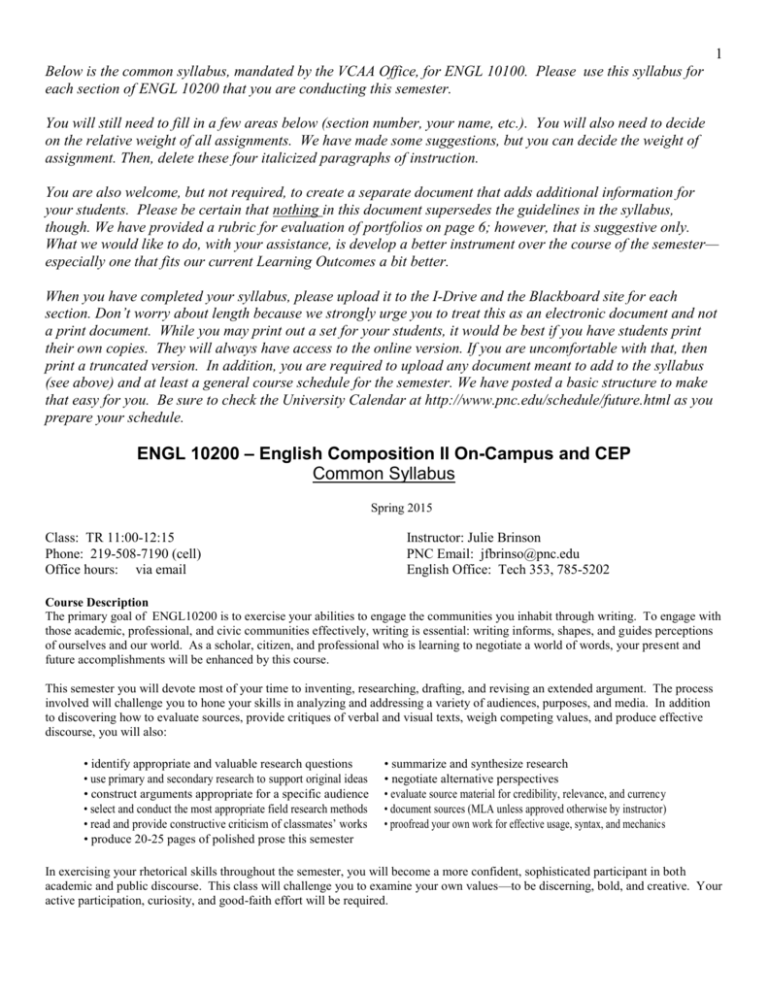
1 Below is the common syllabus, mandated by the VCAA Office, for ENGL 10100. Please use this syllabus for each section of ENGL 10200 that you are conducting this semester. You will still need to fill in a few areas below (section number, your name, etc.). You will also need to decide on the relative weight of all assignments. We have made some suggestions, but you can decide the weight of assignment. Then, delete these four italicized paragraphs of instruction. You are also welcome, but not required, to create a separate document that adds additional information for your students. Please be certain that nothing in this document supersedes the guidelines in the syllabus, though. We have provided a rubric for evaluation of portfolios on page 6; however, that is suggestive only. What we would like to do, with your assistance, is develop a better instrument over the course of the semester— especially one that fits our current Learning Outcomes a bit better. When you have completed your syllabus, please upload it to the I-Drive and the Blackboard site for each section. Don’t worry about length because we strongly urge you to treat this as an electronic document and not a print document. While you may print out a set for your students, it would be best if you have students print their own copies. They will always have access to the online version. If you are uncomfortable with that, then print a truncated version. In addition, you are required to upload any document meant to add to the syllabus (see above) and at least a general course schedule for the semester. We have posted a basic structure to make that easy for you. Be sure to check the University Calendar at http://www.pnc.edu/schedule/future.html as you prepare your schedule. ENGL 10200 – English Composition II On-Campus and CEP Common Syllabus Spring 2015 Class: TR 11:00-12:15 Phone: 219-508-7190 (cell) Office hours: via email Instructor: Julie Brinson PNC Email: jfbrinso@pnc.edu English Office: Tech 353, 785-5202 Course Description The primary goal of ENGL10200 is to exercise your abilities to engage the communities you inhabit through writing. To engage with those academic, professional, and civic communities effectively, writing is essential: writing informs, shapes, and guides perceptions of ourselves and our world. As a scholar, citizen, and professional who is learning to negotiate a world of words, your present and future accomplishments will be enhanced by this course. This semester you will devote most of your time to inventing, researching, drafting, and revising an extended argument. The process involved will challenge you to hone your skills in analyzing and addressing a variety of audiences, purposes, and media. In addition to discovering how to evaluate sources, provide critiques of verbal and visual texts, weigh competing values, and produce effective discourse, you will also: • identify appropriate and valuable research questions • use primary and secondary research to support original ideas • construct arguments appropriate for a specific audience • select and conduct the most appropriate field research methods • read and provide constructive criticism of classmates’ works • produce 20-25 pages of polished prose this semester • summarize and synthesize research • negotiate alternative perspectives • evaluate source material for credibility, relevance, and currency • document sources (MLA unless approved otherwise by instructor) • proofread your own work for effective usage, syntax, and mechanics In exercising your rhetorical skills throughout the semester, you will become a more confident, sophisticated participant in both academic and public discourse. This class will challenge you to examine your own values—to be discerning, bold, and creative. Your active participation, curiosity, and good-faith effort will be required. 2 Typical Course Assignments • Topic proposals • Literature review • Final project • Journal work • Impromptu and supplemental essays assignments • Field research • Participation, homework, tests Course Material • Lunsford. Everyone’s An Author. 1st ed. W.W. Norton & Company, 2013. • Hacker, Diana. A Pocket Style Manual. 5th ed. with 2009 MLA update. New York: Bedford/St. Martin’s, 2010. (Optional) • The Merriam-Webster English Dictionary. Rev ed. New York, Merriam-Webster, 2004. (Optional) Internet Resources • Blackboard: http://blackboard.purdue.edu • PNC Writing Center: http://www.pnc.edu/ll/writing • PNC Library: http://www.pnc.edu/depts/ls/ • Purdue’s OWL: http://owl.english.purdue.edu • MLA Guidelines (2009 update): http://www.wwnorton.com/college/english/write/writesite/MLA_updates.pdf • H- and I- Drive Access: https://home.pnc.edu/NetStorage Special Accommodations If you have a disability that will require accommodation over the course of the semester, please notify the instructor as soon as possible so that your needs can be discussed. If you have not done so already, please also provide appropriate documentation and request accommodations with the Disability Services Coordinator, SWRZ 38, 219-785-5374. Plagiarism Explanations of plagiarism may be found at http://www.pnc.edu/engl/plagiarism.html Also, please see http://www.pnc.edu/engl/plagiarismstate.html for this university’s statements regarding the consequences for plagiarism. The PNC Writing Center has a very useful handout on-line entitled “Avoiding Plagiarism” at http://www.pnc.edu/engl/writingcenter/plag.html Attendance Students are expected to be present for every meeting of the class. Individual instructors determine whether absences may be excused for illness, death in the family, or official university functions, but they are not required to excuse such absences. Federal regulations require that faculty report all students who miss more than two successive class sessions to the Office of the Dean of Students for appropriate action. A student who finds that he or she is unable to attend the class faithfully should consult with an advisor about withdrawing from the course. When a student misses a class, it is his or her responsibility to get class notes and assignments from other students, and consult with the instructor about making up any missed work. Work that is not submitted on the due dates because of absence from class will be penalized, unless students have made satisfactory arrangements with their professors prior to the due date. Absence is no excuse for late or missing work. Your attendance may affect your final grade as follows: Classes that meet three times a week Classes that meet twice a week 3 absences = reduction of 1 letter grade 2 absences = reduction of 1 letter grade 4-6 absences = reduction of 2 letter grades 3-4 absences = reduction of 2 letter grades 5 or more absences = failure in course Classes that meet once a week 1 absence = reduction of 1 letter grade 2 absences = reduction of 2 letter grades 3 or more absences = failure in course *****If the PNC website is not available for more than twelve hours (power outage in Westville, server is down), you can find information about your class at the PNC English Department Facebook site. Evaluation Rubrics for ENGL 10200 Essays 1. Each paper follows the written assignment. 2. Each paper has a clearly defined thesis that is the writer’s own position on the subject is clearly connected to purpose and audience is supported with an appropriate organizational strategy is supported with a balance of generalization and detail is narrow enough to be successfully supported in the essay’s required length 3 3. 4. 5. 6. 7. 8. is supported by effectively synthesizing the writer’s own ideas with outside sources, expressed coherently in the author’s own words Each paper’s organization contributes to the understanding of the thesis through an engaging title and introduction and a conclusion that offers closure effective organization that includes logical and clear arrangement of ideas; unity and coherence of paragraphs; and effective use of transitions Each paper demonstrates critical thinking by using reflective thinking, thoughtful inquiry, and assessment of sources addressing a significant topic and present a rationale for field and library research synthesizing outside sources with the writers own argument and ideas ethically representing the ideas of others (avoids plagiarism) Students demonstrate an understanding of the research process through bibliography and works cited pages that use of a variety of print and electronic sources a field research process that o successfully constructs a mechanism to gather data using case study, survey, interview, or direct observation o successfully cods and analyzes data o successfully negotiates contact with sources o observes ethical guidelines for human subject research consistent with Purdue North Central’s IRB policies Each paper demonstrates a clear understanding of argumentation through a clearly defined argumentative thesis the use of evidence subordinated to the student’s own argument the use of argumentative methods that o are standard o avoid fallacies o use appeals (ethos, logos, pathos) appropriate for specific audiences o represent and address alternative perspectives revisions to improve use of argumentative methods (see above Papers demonstrate an understanding of voice by using original language and vocabulary to convey ideas and make connections addressing a specific discourse community Papers demonstrate an understanding of the nuances of language by using appropriate level of formality using a consistent style and tone avoiding redundancy and wordiness using precise language, avoiding misused words, unidiomatic expressions, jargon, and clichés using language and style appropriate to rhetorical situation, including Standard Written English NOTE: Instructors will use these rubrics in evaluating student writing. How well each piece of work meets these standards will be determined according to a scale set by individual instructors: i.e. A through F, 1 through 6, 100-0, etc. 4 ENGL 10200—English Composition II Inquiry & Argumentation Curriculum Requirements Since ENGL 10200 focuses on argumentation, students are expected to heighten their audience awareness and to tailor their writing to meet audience needs. Students will also read critically to refine their awareness of the critical perspectives of published writers and to recognize the unstated assumptions, claims, and use of evidence in arguments. In addition, students will integrate research with their own thinking. Some work on writing style, including writing for concision and clarity, and proofreading is expected. Essay assignments (approx. 70% of semester grade) • 6,000-8,000 words of polished prose (typically, this would be the total number of words in final drafts) • At least one writing project will integrate multiple outside sources into an argumentative essay, and these sources must be documented according to an appropriate documentation system (e.g., MLA, APA, Chicago Style) • By the end of the semester, all assignments should have completed the required learning outcomes for ENGL 10200 • Types of projects: Rhetorical Analysis of a visual Literature/Media Review Summary/Response Annotated Bibliographies Research Proposals Multiple Source Essay Weblogs Public Writing Group Argumentative Project Research Argumentative Paper Cultural Analysis Literary Analysis Photo documentary Essay Visual Rhetoric Feature Article Reflection 5 Process assignments (aprox. 30% of semester grade)—work that enhances implementation of rhetorical skills and writing to multiple audiences Evaluation Individual instructors will evaluate student work and assign appropriate grades (new faculty must attend a calibration workshop at the start of their first semester). Possible Breakdown: 60% Papers/essays 20% In-class Writing, group work, hand outs, quizzes and other in-class activities 10% Journal Writing 10% Final Presentation ENGL 10100 and 10200 Portfolio Rubric This rubric is a set of guidelines which your instructor will use to evaluate your writing. It describes the qualities your instructor will look for in five important areas: Purpose/Audience, Topic/Thesis, Organization, Prose, and Process. In each column, you will find a general description of what an “A,” “B,” “C,” “D,” or “F” portfolio will look like in terms of one of those five aspects. These descriptions are not meant to be read as items on a checklist but as indications of what a typical A, B, C, D, or F portfolio should look like. It is likely that your own writing has problems in some areas which are partially balanced out by successes in other areas; your instructor will use these descriptions to guide his or her evaluation of the quality of the portfolio as a whole. Criteria A Purpose/ Essays Audience fulfill the assignments in a fresh and mature manner establish the writer's stance with attention and sensitivity to audience, purpose, and context when appropriate to the assignments, demonstrate expertise in employing appeals to ethos, logos, and pathos B Essays follow and fulfill assignments establish the writer's stance demonstrate a clear sense of audience, purpose, and context C Essays follow the assignments demonstrate some sense of audience and purpose D F Essays Essays attempt to follow are inappropriate in the assignments terms of the purposes of the demonstrate little assignments and awareness of their rhetorical rhetorical situation situations may over- or under-estimate (or show no clear purpose or direction ignore) the audience's prior knowledge, assumptions, or beliefs may show little sense of purpose 6 Topic/ Essays Essays Essays Thesis have clearly defined have fairly well have only generally and focused topics defined and focused defined topics topics have clear theses have only general that are supported have thesis thesis statements with specific (and statements which are make responsible use appropriate) adequate but could be of supporting evidence, examples, sharpened evidence which may and details present thorough and be obvious and easily use outside sources more than adequate accessible carefully and cite reasoning and demonstrate little appropriately support awareness of the demonstrate valid demonstrate a topics’ complexities reasoning, good thoughtful awareness or other points of judgment, and an of complexity and view awareness of the other points of view need better topic's complexities development, organization, and reasoning Criteria A B Organ- Essays Essays ization use organizing have an effective strategies introduction and appropriate to conclusion purpose and subject present information use introduction to in a logical order establish context, use well-chosen purpose, and transitions and topic audience sentences use strong, divide paragraphs engaging topic logically sentences provides support for present well thesis, but may need developed to do so in more paragraphs which detail, more progress logically consistently, and/or from what precedes more precisely them present conclusions which go beyond mere restatement of the introduction C Essays may have no thesis statements (or, at best, flawed ones) fail to give obvious evidence may present irrelevant evidence inadequately interpret evidence demonstrate insufficient understanding of the rhetorical situation may rely too heavily on evidence from published sources or lectures without adding original analysis Essays fall seriously short of the minimum length requirements are insufficiently developed do not go beyond the obvious D F Essays Essays Essays are organized in a exhibit deficient are plagued by more fairly clear way organization than one of the organizational could be outlined by a introductions or deficiencies of a D reader, despite conclusions are essay: i.e., occasional lack of not clearly marked introductions or topic sentences or functional conclusions are not have adequately paragraphs are clearly marked or developed and neither coherently functional; appropriately divided developed nor paragraphs are paragraphs arranged neither coherently make transitions topic sentences are developed nor which may be consistently arranged; topic mechanical but foster missing, murky, or sentences are coherence inappropriate consistently transitions are missing, murky, or missing or flawed. inappropriate; transitions are missing or flawed. 7 Prose Essays Essays Essays Essays contain clear, contain clear and exhibit competent may have readable, and readable prose expression numerous and sometimes consistent errors use sentence use relatively simple memorable prose in spelling, usage, structure appropriate sentence structure , and punctuation contain few surface for educated readers, relying on simple and that reveal errors, none of including appropriate compound sentences unfamiliarity with which seriously use of subordination, are generally free of Standard Written undermines the emphasis, sentence sentence-level errors English (or a lack overall effectiveness variety, and modifiers make correct though of careful of the paper for exhibit few sentencelimited word choices proofreading) educated readers level errors contain errors in exhibit stylistic use precise and spelling, usage, and grace and flourishes appropriate punctuation revealing (subordination, vocabulary unfamiliarity with variation of contain punctuation, Standard Written sentence and usage, and spelling English paragraph lengths, conforming to interesting Standard Written vocabulary) English Process Portfolio as a whole demonstrates creative, flexible, and effective revision at both the global and local levels demonstrates familiarity with several methods for generating material (e.g., freewriting, outlining, clustering, etc.) exhibits outstanding improvement in writing over time Essays contain numerous and consistent errors of spelling, usage, and punctuation which hinder communication Portfolio as a whole Portfolio as a whole Portfolio as a whole Portfolio as a whole demonstrates demonstrates some fails to fails to demonstrate effective revision at effective revision at demonstrate any revision both the global and the global level effective revision does not local levels at any but a demonstrates demonstrate superficial level demonstrates familiarity with at familiarity with familiarity with at least one method of does not methods of least two methods for generating material demonstrate generating material generating material (e.g., freewriting, familiarity with does not exhibit any (e.g., freewriting, outlining, clustering.) methods of improvement in outlining, clustering, may not exhibit clear generating writing over time etc.) material improvement in exhibits improvement writing over time does not exhibit in writing over time clear improvement in writing over time
